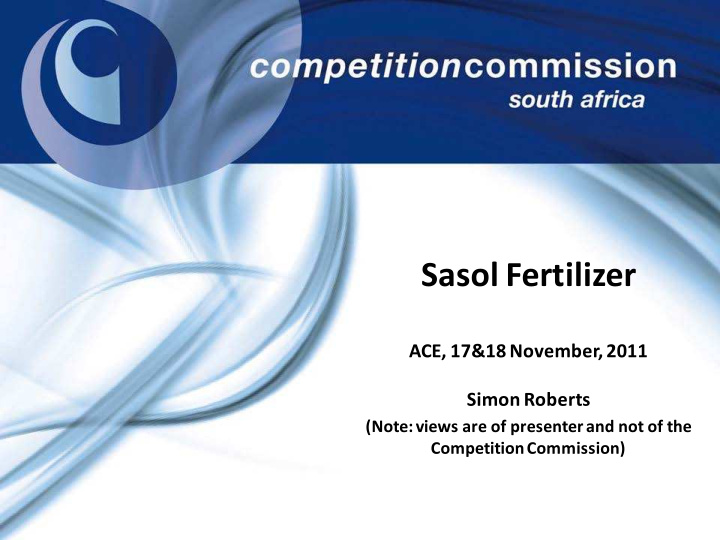



Sasol Fertilizer ACE, 17&18 November, 2011 Simon Roberts (Note: views are of presenter and not of the Competition Commission)
Industry structure Sasol Ammonia Urea Imports Sasol Amm Omnia Amm AECI Amm Nitrate Nitrate Nitrate (incl LAN) (incl LAN) AECI explosives Kynoch/Yara Sasol Ferts & Omnia Ferts Profert Nutriflo (old AECI) Explosives Ferts & Explosives Ferts Ferts Brief history • Sasol formerly state-owned, privatized in 1991. Economy liberalised in mid 1990s. • Sasol and AECI both made ammonia and related products, proposed merger blocked in 1998 • AECI subsequently closed ammonia plant, allegedly for which paid by Sasol • Arrangements between main producers AECI (including fertilizer subsidiary, Kynoch/Yara), Sasol, Omnia include a) long term supply contracts, and b) information exchange through: Nitrogen Balance Committee, Import Planning Committee, Export Club, Fertilizer Society
Background • Sasol prices ammonia at ‘import parity price’ (IPP) based on imputed cost of importing from Middle East / Ukraine into inland South Africa • Ammonia production difficult to vary. Small import quantities mainly to coastal user. Large scale import requires substantial investment. • Sasol, Omnia and AECI make ammonium nitrate • Ammonium Nitrate (AN) based fertilizers made in granular and liquid form, supplied through blending and distribution network; explosives supplied separately • Main granular AN based fertilizer is Limestone Ammonium Nitrate (LAN) • LAN inland priced at urea IPP plus significant premium – this widely known as a pricing rule • Urea all imported, with cost depending on scale of imports • Urea imperfect substitute for LAN, depending soil, crop, time in growing cycle etc (urea as complement for blenders/suppliers?)
Complaints against Sasol, and tests under SA Act • Nutriflo (regional focus) & Profert (national): – Collusion over prices and dividing the market, between Sasol, Omnia and Kynoch Excessive pricing for LAN and ANS – – Exclusionary conduct through a margin squeeze – Price discrimination, in discounts in favour of Kynoch (now Yara), compared to Profert Refusal to supply LAN to Profert – Nutriflo complaint followed steep price increase by Sasol to it, Nutri-Flo later • closed its granulation facility (had moved from liquids specialist into granular). Profert constrained as effective competitor in focus on coastal markets where urea • more attractive SA Act – relevant exclusionary abuse of dominance provisions • Refusal to supply scarce goods to a competitor when is economically feasible (pro- competitive, efficiency defences provided for, in which case must show anti-competitive effects outweigh them) • General exclusion provision (no penalty) where effects outweigh gains • Price discrimination prohibited on part of dominant firm where for equivalent transactions and likely to have effect of substantially preventing or lessening competition. Meeting competition and efficiency defences also provided for.
Case brought and framing of economics of exclusion • Margin squeeze, refusal to supply, general exclusion, and price discrimination on part of Sasol against Profert, Nutriflo. • Effects associated with Sasol protecting its quasi-monopoly position, and its exertion of market power, in ammonia and ammonium nitrate • Sasol advantage given to Omnia and Yara as these firms with better by-pass options, bargaining power: – Kynoch/Yara historically part of AECI, now part of fertilizer multinational and able to import cheaply via parent – Omnia could enter ammonia (including through bulk imports) – Ensure margins at blending/distribution level for these firms through discounts, in return for purchasing ammonia and AN from Sasol – Sales to coastal and export markets at lower ex-works prices than to inland Collusion based mainly on committees (other info on further meetings) • • Excessive pricing of ammonia and ammonium nitrate
Maintaining monopoly position and ability to earn returns, or competition on the merits? • Effects on competition and on welfare • Exclusionary rationale? – What sources of direct and indirect competitive discipline may undermine the one monopoly profit? – Commitment problem? After making sales at monopoly price, is incentive to sell additional volumes at discounts rather than sell into lower priced markets – By-pass and potential bargaining power? Presence of imperfect alternatives and cost that can be imposed on Sasol given economics of ammonia. – Protection of ‘base’ or ‘home’ market? • Is there a monopoly profit to protect? • Does the differential pricing mean more sales are made, enhancing welfare? • Factual disputes: – substitutability of urea and anti-competitive effect? For blenders? Yara by-pass? – supply/demand balances in inland market; IPP pricing exploitative from ‘shorting’ market, or outcome of welfare enhancing discrimination? • Role of coordination, info exchange? A double margin, protected by Sasol?
Settlement • Sasol admitted cartel in 2009 (further evidence of meetings) • Sasol settled abuse cases in 2010: – Divestiture of five blending plants around the country (retained one inland) – Non-discrimination by customers’ location and sales essentially on ex- works basis – Cease importation of ammonia for third parties – Undertakings not to reduce supply, commitment to continue with planned investments – No admission
Recommend
More recommend